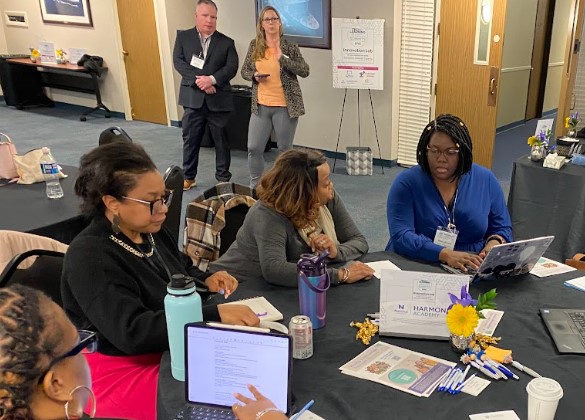
The Tech & Learning Regional Leadership Summits are unique opportunities to engage with other school and district leaders whose work draws from national, state, and edtech organization standards such as NGSS, CCSS, and ISTE. For educators, it provides a think-tank like space to dream and build innovative and accessible futures for learners.
At this year’s Delaware, Maryland, and Virginia regional event held at the Maritime Conference Centre in Baltimore, teams of colleagues, many meeting for the first time, worked throughout the day to craft their own versions of schools based on the new National Educational Technology Plan. Much of the content used to inspire the building of these model learning centers derived from the different sessions from throughout the day.
Breaking the AIce
Naturally, AI was a topic on everyone’s mind, and as such, the day started with a fun icebreaker developed by the summit’s trusted and enthusiastic facilitator, Carl Hooker, called “KarAIoke.” In the activity, attendees had to guess popular songs based on AI-generated images. The icebreaker was a massive hit and provided a fun opportunity for teams to work together and experience using AI in a low-risk and exciting way.
Emerging Tech
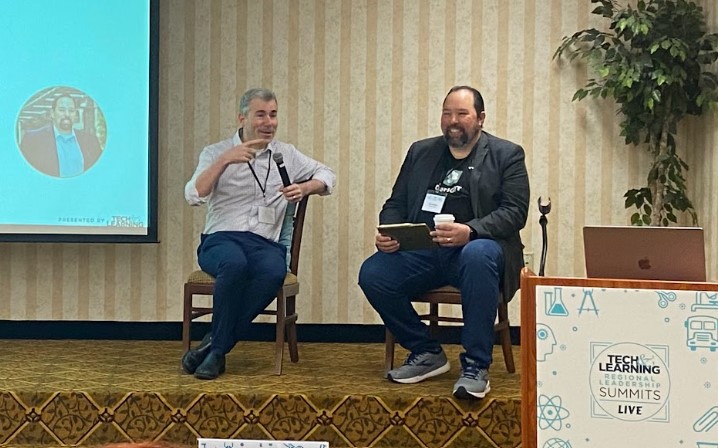
ISTE CEO Richard Culatta sat down for an intimate chat with Carl Hooker to discuss emerging tech trends on the horizon. Culatta reminded the school and district leader attendees that the trends over the year of AI is the equivalent of 100 years of ed policy change. Meaning, it is moving quite expeditiously!
Culatta highlighted the importance for educators to have an understanding that ChatGPT is not AI, but instead is one tech tool that uses generative AI, and that there is a shift from generalist AI to specialist AI. For example, StretchAI for education is in Beta testing, and it relies on a “walled garden” approach in which all the data fed it is carefully curated by ISTE and ASCD. This is important because it protects the accuracy of the information.
Moving from a primary focus on academic integrity concerns with AI, Culatta highlighted three trends in schools that are doing AI right:
- Time to Tinker with AI: Providing time for educators to explore using different types of generative AI. Some schools use the weekly faculty meeting time to allow for open experimentation with AI tools.
- Modeling AI Use: Leaders in schools are modeling use of AI. For example, a school leader will include an AI-generated image in their weekly newsletter to show it is ok to use AI in fun ways for teachers.
- Talking to Students about AI: Instead of banning AI outright, schools are having intentional discussions with students on what AI is and how it could or should be used or should not be used. For example, kids can consider how they can use AI to support writing a college application essay or not; having the discussion is key here.
Future of Education
Sharing that one constant in edtech is change and that none of the top five issues from ten years ago are the same as today is how Keith Krueger, CEO of CoSN, started his presentation on the future of education. Krueger showed images of “older” tech (cell phone brick, palm pilot, disk man, large computers) that in many ways still perform the same functions that we rely on currently, but we use newer technologies to do so. This was a great reminder to focus on the function of technology as opposed to specific tech tools, and then laid the foundation for presentation nicely.
Kreuger’s three big challenges that affect tech leaders are:
- Cybersecurity: Since 2018, cybersecurity concerns continue to increase, and K-12 schools are the No. 1 targeted population for ransomware attacks, at 57%. Unfortunately, there is not a lot of protection of data or people keeping things secure in K-12, and districts have large amounts of employee and student personal information, including SSNs, DOBs, and addresses. The impact of ransomware includes lost learning time and loss of reputation. The CoSN website provides resources that districts can access to be more proactive in addressing cybersecurity.
- Digital Equity: Despite increased focus on access, which can still be a challenge, student connectivity remains an equity issue. The type of device matters (not all devices can do video conferencing for example), and what the government considers being a high connection internet speed is not sufficient for remote learning tools. As we move into the future, underconnectivity will be a focus and ensuring that not only do all students have a device, but they have the right device to handle robust computing and enough processing.
- AI in K-12: AI will undoubtedly be a challenge going forward. Currently, there have been three responses from school districts regarding AI use: ban it, embrace it, and duck and cover. CoSN is working on providing supports for districts and has created a K-I2 generative AI readiness checklist and toolkit. AI’s cross-cutting impact with cybersecurity, as well as its influence on analytics and adaptive technologies, are also areas to watch.
Other Emerging Topics Explored During the Summit
The day was quite full, and a dozen other topics were presented and discussed. Some of the highlights include:
Esports: An Esports presentation by Tarrin Morgan from Morgan State University and CEO of REALdigitizED was exceptional, and showed the alignment between esports, student wellness, and career readiness, amongst many other areas.
Esports has existed since 1972 and is a testament to the power of computing. Individual growth benefits to students who participate include:
- Emotional, mental, and physical wellness
- Analytical and critical thinking
- Increased hand-eye coordination (i.e. transferable skill to be a surgeon)
- Learning to be a good teammate and leader
- Effective communication skills
- Networking and community building
- Adaptability
- Strategic planning (shooting and building at the same time)
- Computer fluency (many video games reply on coding skills)
- Extends STEM career opportunities (e.g. cybersecurity, animation, game design and coding, sound design, block chaining - dealing with digital currency)
NextGen Science Standards in Action: Dr. Godfrey Rangasammy and Jessica Leedy from Prince George’s County School District provided insights on changing the STEM status quo through an equity lens by working toward justice-centered and multilingual science education. They shared how they have helped their students think about how they can change the world through teaching, using the NGSS. Their work is a culmination and continuation of a decade’s worth of innovation, curriculum audits in grades 3-8 biology, ambitious science teaching, and using AI + Scratch for multilingual cohorts as well as K-5 robotics in science instruction.
The Shifting Role of Edtech Coaches: Dr. Amy Jackson and Krystle Pearson discussed the shifts in instructional coaching in this post-pandemic era, recognizing that many teachers have fatigue with using tech tools. Change management using Kotter’s method was suggested as well as intentional long-term planning with other coaches by forming coaching teams with reading, math, and science coaches as edtech coaches are curriculum agnostic. Modeling digital pedagogy, engaging in more collaborative learning, and focusing on capacity building were advised.
Putting a Bow on the Learning
The day concluded with the group presentations of model schools, which were showcased with walkup music, in poetry form, and featuring the D-ID avatar generator. Model school examples had eco-friendly materials, including state-of-the-art tech tables, and focused on developing students’ soft-skills, cultural competence, and engagement with community and industry partners.
After the model school presentations, the Innovative Leader Award winners were recognized, including:
Best Example of Innovative Digital Curriculum: Amanda Lanza and Valerie Schaffer, Baltimore County Public Schools
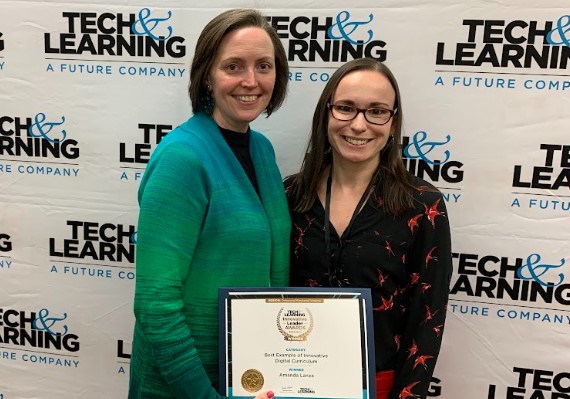
Best Example of Providing Equity & Access: Godfrey Rangasammy and Jessica Leedy, Prince George’s County Public Schools
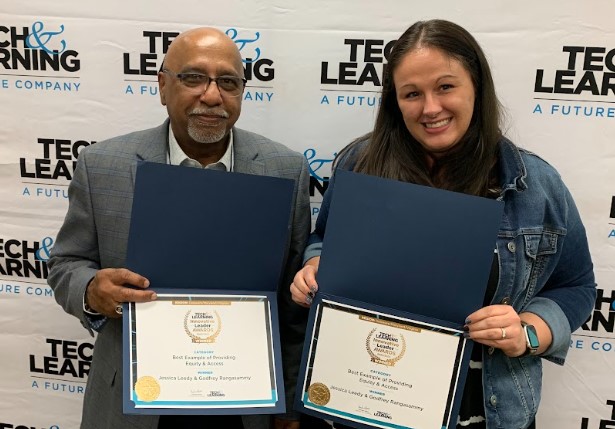
Innovative Chief Technology Officer: Chad McGaha, Belton ISD
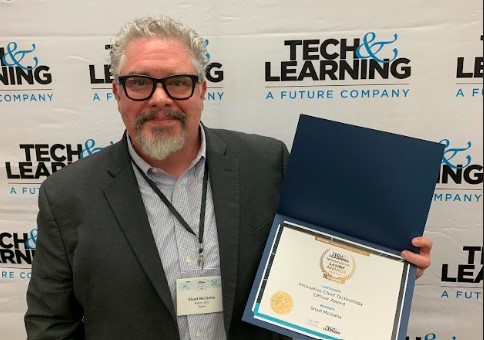
The Tech & Learning Regional Leadership Summits are one-of-a-kind opportunities to learn, network, and be on the edge of all things new in edtech. Use some of the information shared in your own work and join us in the future!







